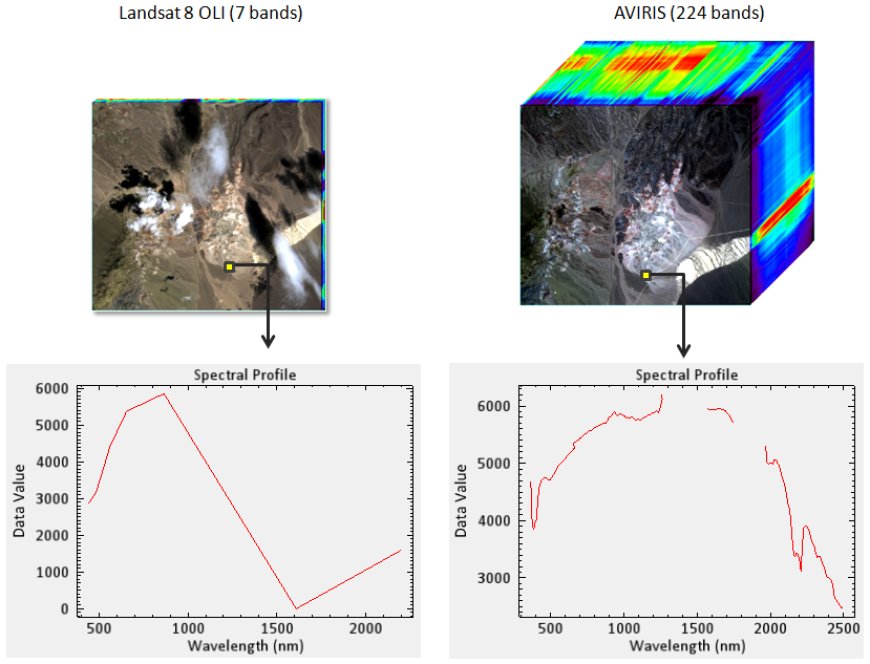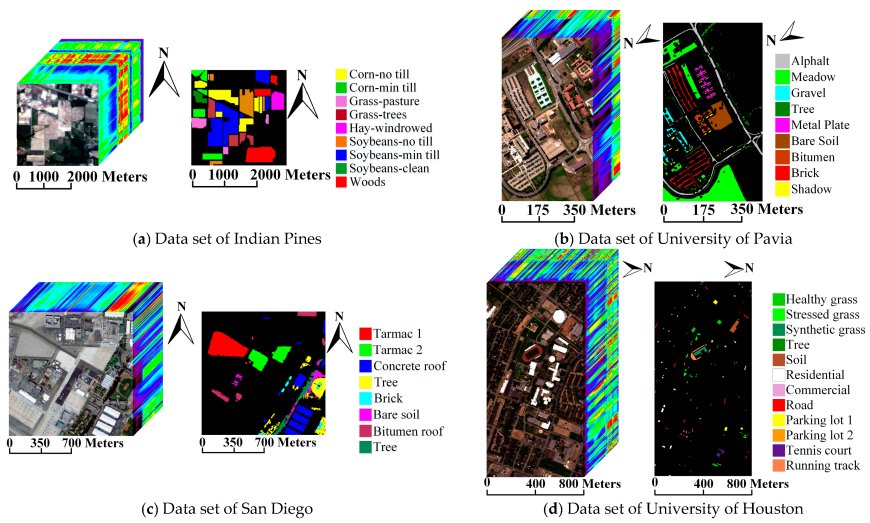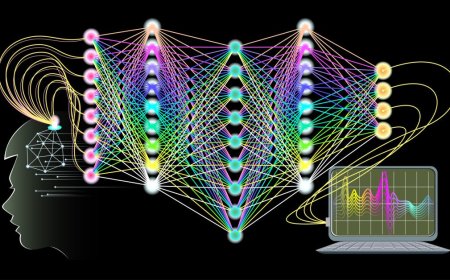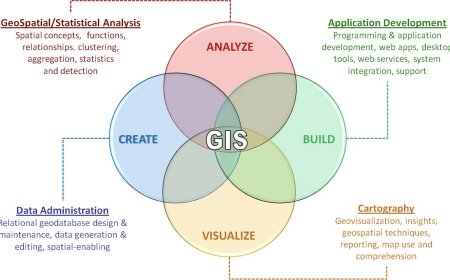Hyperspectral Satellite Image Processing with Spectral Python: Applications, Advantages, and Disadvantages
This blog discusses the use of Spectral Python for processing hyperspectral satellite images, covering its advantages, disadvantages, and applications in various fields such as agriculture, environmental monitoring, mineral exploration, forensics, and medical imaging.

Hyperspectral satellite image processing has become increasingly popular over the years, with the advent of more advanced remote sensing technologies. Hyperspectral data refers to images that have been captured across a range of different wavelengths, allowing for the detection of unique spectral signatures that can be used to identify various features on the Earth's surface. Spectral Python (SPy) is a popular open-source software package that can be used for hyperspectral image processing, analysis, and visualization. In this article, we will discuss the basics of hyperspectral satellite image processing with SPy.
Understanding Hyperspectral Data
Before we dive into the specifics of using SPy, it is important to have a basic understanding of hyperspectral data. Hyperspectral images are made up of multiple spectral bands, typically ranging from a few dozen to several hundred. These bands capture reflectance values across different wavelengths, allowing for the detection of unique spectral signatures for different features on the Earth's surface.

Each pixel in a hyperspectral image has a reflectance value across all of the available bands, resulting in a multi-dimensional array of data. This data can be analyzed using a variety of techniques, including classification, feature extraction, and anomaly detection.
Using Spectral Python for Hyperspectral Image Processing
Spectral Python (SPy) is an open-source software package that provides a wide range of tools for hyperspectral image processing. It is written in Python, making it easy to integrate with other scientific computing libraries such as NumPy, SciPy, and Matplotlib.
SPy provides a variety of functions for loading and processing hyperspectral data, including functions for reading data from a variety of file formats, performing radiometric and atmospheric corrections, and visualizing the data.
Loading Hyperspectral Data
The first step in working with hyperspectral data in SPy is to load the data into a Python array. SPy provides several functions for loading data from different file formats, including ENVI, HDF, and TIFF.
For example, to load a hyperspectral image in ENVI format, you can use the following code:
from spectral import *
img = open('path/to/image.hdr')
This will load the image into a Python object called "img", which can be used for further processing and analysis.
Visualizing Hyperspectral Data
Visualizing hyperspectral data can be challenging due to the large number of spectral bands and the complex nature of the data. SPy provides several functions for visualizing hyperspectral data, including functions for creating false-color images and spectral plots.
For example, to create a false-color image of a hyperspectral image, you can use the following code:
from spectral import *
img = open('path/to/image.hdr')view = imshow(img, (29, 19, 9))
This will create a false-color image using bands 29, 19, and 9, which are typically used to highlight vegetation, water, and soil features, respectively.
Performing Radiometric Corrections
Radiometric corrections are essential for ensuring that the data captured by a hyperspectral sensor is accurately represented in the image. SPy provides several functions for performing radiometric corrections, including functions for dark current correction, flat field correction, and gain correction.
For example, to perform a dark current correction on a hyperspectral image, you can use the following code:
from spectral import *
img = open('path/to/image.hdr')
img_dark = open('path/to/dark_current.hdr')
img_corr = img - img_dark
This will subtract the dark current image from the original image, resulting in a corrected image that has had the dark current noise removed.
Performing Atmospheric Corrections
Atmospheric corrections are essential for removing the effects of atmospheric interference on hyperspectral data. SPy provides several functions for performing atmospheric corrections, including functions for correcting for aerosol scattering and water vapor absorption.
For example, to perform an atmospheric correction on a hyperspectral image using the FLAASH algorithm, you can use the following code:
from spectral import *
img = open('path/to/image.hdr')
hdr = envi.read_envi_header('path/to/atmospheric_parameters.hdr')
img_corr = envi.flaash(img, hdr)
This will apply the FLAASH atmospheric correction algorithm using the atmospheric parameters specified in the header file.
Performing Spectral Analysis
Spectral analysis is an important step in hyperspectral image processing, as it allows for the identification of unique spectral signatures for different features on the Earth's surface. SPy provides several functions for performing spectral analysis, including functions for calculating spectral indices, performing principal component analysis (PCA), and clustering.
For example, to calculate the normalized difference vegetation index (NDVI) for a hyperspectral image, you can use the following code:
from spectral import *
img = open('path/to/image.hdr')
ndvi = (img[:,:,30] - img[:,:,16]) / (img[:,:,30] + img[:,:,16])
This will calculate the NDVI using bands 30 and 16, which are typically used to highlight vegetation features.

Spectral Python Machine Learning Algorithms
Spectral Python also provides a variety of machine learning algorithms that can be used for classification and prediction tasks. Here are a few of the machine learning algorithms available in Spectral Python:
-
Support Vector Machines (SVM): SVM is a powerful algorithm for classification tasks that works by finding the hyperplane that maximally separates different classes of data. SVM has been used in many remote sensing applications, including land cover classification and mineral mapping.
-
Random Forest: Random Forest is a decision tree based algorithm that can be used for both classification and regression tasks. A random forest works by building multiple decision trees at training time and class output that represent the state of the class (classification) or mean prediction (regression) of the individual trees.
-
Convolutional Neural Networks (CNN): CNN is a type of deep learning algorithm that has been used in many image classification tasks. CNN works by learning a set of filters that can be applied to an image to extract features, which are then used to make predictions about the image's class.
-
Principal Component Analysis (PCA): PCA is a dimensionality reduction algorithm that can be used to reduce the number of features in a dataset. PCA works by finding the principal components of the data, which are the directions in which the data varies the most. PCA is often used in hyperspectral image analysis to reduce the dimensionality of the data and improve classification accuracy.
Applications of Hyperspectral Image Processing with Spectral Python
-
Agriculture: Hyperspectral imaging can be used to monitor crop health, detect pests and diseases, and assess soil fertility. With Spectral Python, users can perform spectral analysis on hyperspectral data to identify unique spectral signatures for different crops and monitor their health over time.
-
Environmental Monitoring: Hyperspectral imaging can be used to monitor the health of ecosystems, track changes in land use, and assess the impact of natural disasters, such as wildfires or floods. With Spectral Python, users can analyze hyperspectral data to detect changes in vegetation, water quality, and land cover over time.
-
Mineral Exploration: Hyperspectral imaging can be used to detect and map mineral deposits, including ores, rocks, and soils. With Spectral Python, users can perform spectral analysis on hyperspectral data to identify unique spectral signatures for different minerals and create mineral maps that can be used for exploration and mining.
-
Forensics: Hyperspectral imaging can be used in forensic investigations to identify trace evidence, such as fibers, powders, and fluids. With Spectral Python, users can analyze hyperspectral data to identify unique spectral signatures for different types of evidence and use this information to identify suspects or link crimes to specific locations.
-
Medical Imaging: Hyperspectral imaging can be used in medical imaging applications, such as cancer detection, tissue analysis, and drug development. With Spectral Python, users can analyze hyperspectral data to identify unique spectral signatures for different tissues and cells and use this information to develop new medical imaging techniques and treatments.
Advantages of Hyperspectral Image Processing with Spectral Python
-
Open-Source: Spectral Python is an open-source software package, which means that it is freely available for anyone to use and modify. This makes it an ideal tool for researchers and developers who need to customize their image processing workflows or develop new algorithms.
-
User-Friendly: SPy provides a user-friendly interface that makes it easy to load, visualize, and process hyperspectral data. The software package also provides detailed documentation and a wide range of tutorials and examples, making it accessible to users of all skill levels.
-
Wide Range of Functions: SPy provides a wide range of functions and tools that can be used for processing and analyzing hyperspectral data, including radiometric and atmospheric corrections, spectral analysis, and visualization. This makes it an ideal tool for a variety of applications, including agriculture, environmental monitoring, and mineral exploration.
-
Integration with Other Python Libraries: SPy can be easily integrated with other Python libraries, such as NumPy, SciPy, and scikit-learn, making it a powerful tool for data analysis and machine learning applications.
Disadvantages of Hyperspectral Image Processing with Spectral Python
-
Steep Learning Curve: While SPy provides a user-friendly interface and detailed documentation, it can still be challenging for users who are new to hyperspectral image processing. The software package requires a solid understanding of remote sensing concepts and image processing techniques, which may be difficult for beginners to grasp.
-
Limited Support: SPy is an open-source software package, which means that support is primarily provided by the user community. While there is an active user community and many resources available, including tutorials and examples, users may not receive the same level of support as they would with a commercial software package.
-
Limited Processing Power: SPy is a software package that runs on a desktop or laptop computer, which means that it may be limited in terms of processing power. Large hyperspectral datasets may require significant computational resources, which may not be available on a typical desktop or laptop computer.
Conclusion
Hyperspectral image processing with Spectral Python is a powerful tool that provides a wide range of functions and tools for processing and analyzing hyperspectral data. While there are some limitations to using open-source software, the benefits of using SPy, including its user-friendly interface, wide range of functions, and integration with other Python libraries, make it an ideal tool for researchers and developers working with hyperspectral data. As hyperspectral data becomes increasingly important in a wide range of applications, including agriculture, environmental monitoring, and mineral exploration, SPy will likely continue to be an important tool in the field of remote sensing.
What's Your Reaction?






































